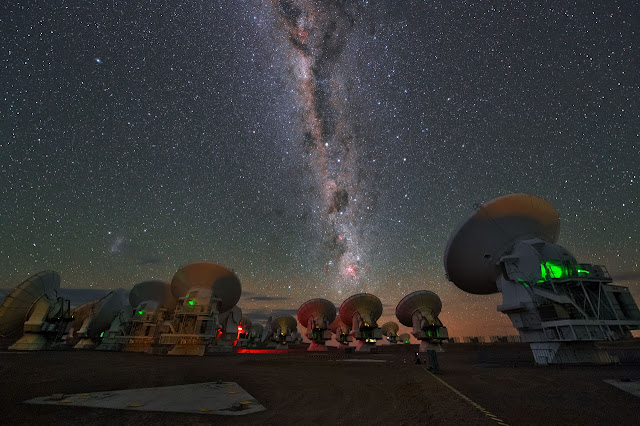Collage of many of the young star clusters observed with ALMA as part of the ALMAGAL survey.
Credit: ALMA (ESO/NAOJ/NRAO)/S. Molinari et al.
Credit: ALMA (ESO/NAOJ/NRAO)/S. Molinari et al.
The ALMA antennas observe the Milky Way high up in the Chajnantor Plateau in Chile’s Atacama Desert.
Credit: ESO/Y. Beletsky
Credit: ESO/Y. Beletsky
Stars are massive spheres of plasma, nuclear reactors that illuminate the universe. But where do they come from? We know they form in vast clouds of gas and dust, which collapse into smaller fragments. However, the details of how this happens remain unclear. A groundbreaking survey of 1,000 stellar nurseries is helping to answer this question.
Look up at the night sky and observe our galaxy, the Milky Way. Among the countless stars are clouds of gas and dust that work tirelessly like true factories to create new stars.
Much like some of the factories on Earth, these clouds use simple building blocks (hydrogen, helium, and small amounts of heavier elements) to make more complex pieces like stars. However, not all factories operate the same way. Some produce stars at different rates, with varying masses and compositions. What is happening behind the scenes?
Astronomers have long studied individual stellar nurseries, but how do their findings apply on a larger scale? We need a broader view to develop a universal model of star formation. That is where ALMAGAL comes in.
Look up at the night sky and observe our galaxy, the Milky Way. Among the countless stars are clouds of gas and dust that work tirelessly like true factories to create new stars.
Much like some of the factories on Earth, these clouds use simple building blocks (hydrogen, helium, and small amounts of heavier elements) to make more complex pieces like stars. However, not all factories operate the same way. Some produce stars at different rates, with varying masses and compositions. What is happening behind the scenes?
Astronomers have long studied individual stellar nurseries, but how do their findings apply on a larger scale? We need a broader view to develop a universal model of star formation. That is where ALMAGAL comes in.
A Thousand Star-Forming Regions Under the Lens
The ALMAGAL survey, using the Atacama Large Millimeter/submillimeter Array (ALMA), examines more star-forming regions than ever before: three to four times more than all previous surveys combined, with remarkable detail.
The survey has observed 6,000 cores and 800 clumps, revealing key insights:
- Not all star-forming regions are the same.
- More material leads to higher star production. Massive clumps produce more and larger cores, fueling star growth.
- Clumps evolve over time. Initially circular, they become more intricate as they fragment into cores. Some massive clumps remain unbroken, likely because they are still young.
While ALMAGAL has already deepened our understanding of star birth, many questions remain. Researchers now aim to explore how the gas flows from clumps into cores and how newborn stars influence this process. Thanks to ALMAGAL’s extensive dataset, we are closer than ever to unraveling the secrets of star formation and even the origins of planetary systems.
Additional information
The description of the ALMAGAL survey and the first results are described in the following papers published in Astronomy & Astrophysics:
- ALMAGAL I. The ALMA evolutionary study of high-mass protocluster formation in the galaxy. Presentation of the survey and early results
- ALMAGAL II. The ALMA evolutionary study of high-mass protocluster formation in the galaxy. ALMA data processing and pipeline
- ALMAGAL III. Compact source catalog: Fragmentation statistics and physical evolution of the core population
This post is based on the original published by the European Southern Observatory (ESO), an ALMA partner on behalf of Europe.
The Atacama Large Millimeter/submillimeter Array (ALMA), an international astronomy facility, is a partnership of the European Southern Observatory (ESO), the U.S. National Science Foundation (NSF), and the National Institutes of Natural Sciences (NINS) of Japan in cooperation with the Republic of Chile. ALMA is funded by ESO on behalf of its Member States, by NSF in cooperation with the National Research Council of Canada (NRC) and the National Science and Technology Council (NSTC) in Taiwan, and by NINS in cooperation with the Academia Sinica (AS) in Taiwan and the Korea Astronomy and Space Science Institute (KASI).
ALMA construction and operations are led by ESO on behalf of its Member States; by the National Radio Astronomy Observatory (NRAO), managed by Associated Universities, Inc. (AUI), on behalf of North America; and by the National Astronomical Observatory of Japan (NAOJ) on behalf of East Asia. The Joint ALMA Observatory (JAO) provides the unified leadership and management of ALMA's construction, commissioning, and operation.
The Atacama Large Millimeter/submillimeter Array (ALMA), an international astronomy facility, is a partnership of the European Southern Observatory (ESO), the U.S. National Science Foundation (NSF), and the National Institutes of Natural Sciences (NINS) of Japan in cooperation with the Republic of Chile. ALMA is funded by ESO on behalf of its Member States, by NSF in cooperation with the National Research Council of Canada (NRC) and the National Science and Technology Council (NSTC) in Taiwan, and by NINS in cooperation with the Academia Sinica (AS) in Taiwan and the Korea Astronomy and Space Science Institute (KASI).
ALMA construction and operations are led by ESO on behalf of its Member States; by the National Radio Astronomy Observatory (NRAO), managed by Associated Universities, Inc. (AUI), on behalf of North America; and by the National Astronomical Observatory of Japan (NAOJ) on behalf of East Asia. The Joint ALMA Observatory (JAO) provides the unified leadership and management of ALMA's construction, commissioning, and operation.
Contacts:
Nicolás Lira
Education and Public Outreach Coordinator
Joint ALMA Observatory, Santiago - Chile
Phone: +56 2 2467 6519
Cel: +56 9 9445 7726
Email: nicolas.lira@alma.cl
Bárbara Ferreira
ESO Media Manager
Garching bei München, Germany
Phone: +49 89 3200 6670
Email: press@eso.org
Jill Malusky
Public Information Officer
NRAO
Phone: +1 304-456-2236
Email: jmalusky@nrao.edu
Yuichi Matsuda
ALMA EA-ARC Staff Member
NAOJ
Email: yuichi.matsuda@nao.ac.jp

